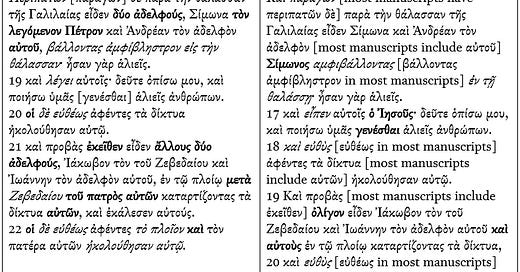(avg. read time: 14–28 mins.)
Part 1: Matt 4:23 // Mark 1:39 // Luke 4:44
Part 3: Matt 4:1–11 // Mark 1:12–13 // Luke 4:1–13
Part 4: Matt 3:1–17 // Mark 1:2–11 // Luke 3:1–9, 11–15, 21–22 // John 1:19–34
Part 5: Matt 7:28–29 // Mark 1:21–22 // Luke 4:31–32
Part 6: Matt 5:1–12 // Luke 6:20–26
Part 7: Matt 4:12, 17 // Mark 1:14–15 // Luke 4:14–15
As outlined in my first post in this series, today we will be moving to an analysis of a parallel between only two Gospels. This installment will examine Matt 4:18–22 // Mark 1:16–20, the calling of the disciples in each Gospel. Nestle-Aland also identifies Luke 5:1–11 as a parallel and points to John 1:35–42 as well. I have elected to omit these texts from the analysis here and thus from my tabulation of overall similarity scores for three reasons. One, although I have made clear that I am not convinced of this (see here), Luke 5:1–11 has sometimes been posited as having some kind of traditional and/or textual relationship with the story of John 21, and I am planning to cover that separately in the commentary (unfortunately, it will not be posted this year). I am avoiding double-counting of any apparent similarities in my tabulations, and while Luke 5 and John 21 diverge significantly on the lexical level, Luke 5 is still closer to that text than it is to the other Synoptics. Two, following on that point, while they are parallel stories, there is not nearly as much in the way of verbal similarities of Luke and/or John with Matthew and/or Mark. Matthew and Mark are much, much closer to each other than any of the other Gospel accounts are to them. All that adding these texts to this part of the analysis would do is drive down the similarity scores for Luke and John with Matthew and Mark, and my calculations have attempted to be generous in erring on the side of counting similarities without double-counting. Three, although I admittedly do not apply this last reason consistently to disqualify from this analysis (as with the temple incidents), while Matthew and Mark clearly tell the same story, it is not obvious that the other texts are even attempting to tell the same story, even if they occupy nearly similar positions in the overall narratives.
Again, I will reiterate what I said previously about my approach in marking these parallels. For all texts, plain font words are absolute similarities between texts, regardless of where they appear in word order and without repetition (if one word appears once in one text and twice in another, it is only counted once, and so on). Italics signify either a different form of the same word or a synonymous word paralleled in each text. Bold font signifies what is unique to each text. The Greek is taken from NA28 and the similarity scores outlined below are based on this text. Brackets include variants attested in at least five Greek witnesses that make the text closer to parallels. Alternatively, brackets may feature text-critical notes on what the majority of texts include or lack.
For each text, I will give two scores of similarity to each of the other Gospels: one will be cases of absolute matching and the other will be cases of “weighted” matching, not counting variants (assigning a value of 1 to absolute matches, 0.75 to alternate forms of the same word and 0.5 to synonyms). There is no easy way to account for variation in word order in these similarity scores, thus my only solution to make note of these variations is to put a < symbol next to scores to signify that the verbal similarity is actually less than the calculated score would indicate because of the difference in word order where the wording is otherwise similar.
Text-critical Observations



